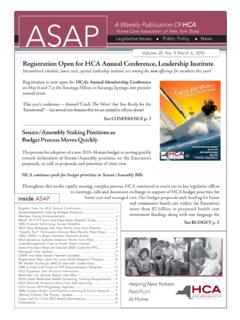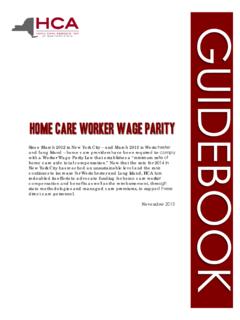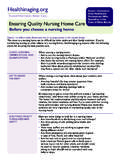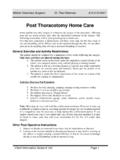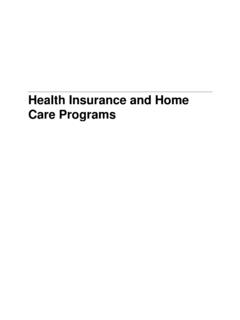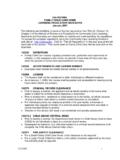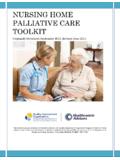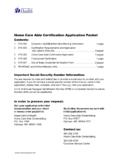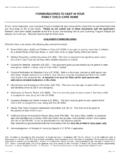Transcription of NEW YORK HOME CARE - HCA-NYS – Home Care …
1 NEW york home care TYPES OF AGENCIES home care is an integral component of the long term care continuum, providing quality, cost-effective health care services not only in individuals private homes, but in assisted living, senior housing, and naturally occurring retirement communities. " home care " refers to a wide range of health and social services, including medical, nursing, social, or therapeutic treatment and/or assistance with the essential activities of daily living. Generally, home care is appropriate whenever a person prefers to stay at home , or is homebound, but needs ongoing care that cannot easily or effectively be provided solely by family and friends. home health care services are routinely provided to the elderly, patients of all ages who are disabled or recuperating from acute illness, and chronically ill infants, children, and adults. In addition, adults and children diagnosed with terminal illness also are being cared for at home , receiving compassionate care and maintaining dignity at the end of life.
2 Although there are many types of home care programs, there are three basic types of home care providers or agencies in New york State: CHHAs or certified home health care agencies; LTHHCPs or long term home health care programs; and LHCSAs or licensed home care services agencies (including home Attendant Programs). CHHAs are authorized to serve both Medicare beneficiaries and Medicaid recipients in need of short-term, skilled nursing care and provide: Nursing services; Medical supplies; Equipment/appliances for home use; home health aide services; Physical, occupational and speech therapies; Nutritional services; Social work; and Personal care , homemaker and housekeeper services. A typical CHHA patient would be someone recovering from surgery that requires intensive follow-up, but is physically unable to visit the physician s office or go to outpatient treatment. Most CHHA patients only require services for a few weeks, but in some cases receive care for an extended period of time.
3 LTHHCPs are also known as nursing homes without walls and have a single focus: providing comprehensive services in the home for individuals who might normally be in nursing homes. LTHHCPs are agencies of hospitals, nursing homes or CHHAs which are separately certified to provide a long term home health care program. LTHHCP services are enhanced under a federal waiver for home and community-based services. Some of the many services included in the LTHHCP are: Comprehensive case management; Skilled nursing; Physical, occupational, and respiratory therapies; Speech pathology and audiology; home health aide and personal care services; Housekeeper and homemaker services; Medical equipment and supplies; Medical transportation; Medical social work services; and Nutrition counseling. Additional services may also include (through the program s federal waiver): Respite services; Personal emergency response system services; Housing improvement ( home adaptation) services; home maintenance tasks, moving assistance (to relocate patients from nursing homes or nonviable home settings to viable homes); and Social day care , social transportation, and congregate and home delivered meals.
4 A typical LTHHCP recipient might be someone with chronic care needs, such as diabetes or congestive heart failure. LTHHCP patients often receive services for one, two, or in some cases, many years. LHCSAs either contract with CHHAs, LTHHCPs or local social services districts, or provide on their own (for non-Medicaid and non-Medicare cases), at least one of the following services: Nursing; home health aide; Personal care or homemaker Physical/occupational and speech therapies; Private duty nursing A typical LHCSA patient could be: A CHHA patient who requires a home health aide following surgery; A patient in a LTHHCP that needs assistance with activities of daily living; or A child receiving private duty nursing services. LHCSA patients may be either short or long term, depending on the situation. TYPES OF PROGRAMS Beyond the three basic types of home care agencies, New york State has a comprehensive system of home and community-based care programs that has developed over the past thirty years.
5 These programs have evolved to meet the changing needs of our health care system and provide acute, short-term, chronic long-term and public health preventive care . In this state, there are over 111,000 home care workers providing care to over 400,000 individuals. New york also has programs that serve a particular population with special needs, such as the care At home (CAH) program for children, Traumatic Brain Injury (TBI) waiver, Managed Long Term care (MLTC), Consumer Directed Personal Assistance Program and Hospice. In addition, programs are available for those not eligible for Medicaid and include Expanded In- home Services for the Elderly Program (EISEP), respite care , home delivered meals, and telephone reassurance services. The case studies on the next page help illustrate the varied roles of New york s home care agencies and programs. But most importantly, they help put a face to the hundreds of thousands of patients we serve.
6 The agencies and cases described in this next section are also often assisted by licensed home care services agencies under contract with the supervising agencies and programs ( , CHHAs, LTHHCPs). The licensed agencies often help provide essential portions of the care plans required by home care patients, in conjunction with the supervising agency or program. Licensed agencies also contract with local departments of social services for the provision of county-run personal care services to Medicaid recipients. COVERAGE OF home care SERVICES home care services are covered by Medicare, Medicaid, private health insurance, state and local funds under EISEP, and on a private pay basis. Each payor has specific criteria for what, when and how much home care will be covered, but Medicaid provides by far the broadest coverage. All of the payors require that services be provided based on their necessity and pursuant to a physician s order.
7 Additional rules and procedures may be applied when the coverage is provided in connection with an HMO or other managed care plan. Coverage of certain services, like LTHHCP, TBI and care at home are also enhanced through special Federal Medicaid waivers approved for the State. CASE STUDIES: PATIENTS AT home Mrs. G Receives Medicare Certified Services Mrs. G is a 77-year old woman who has diabetes, high blood pressure and bronchitis. She lives in an apartment building in the Bronx. Last winter, she slipped on ice outside of her building and broke her hip. She was transported to the hospital and underwent hip replacement surgery. Following the surgery and some therapy in the hospital, she was sent home . A nurse from a CHHA visited her at home and arranged Medicare-covered home care services. These included a weekly nurse, occupational therapy twice a week for one week, physical therapy twice a week for a month, and a home health aide four hours a day five days a week.
8 The physical therapist visited once a week for an additional two months and the nurse visits were reduced to one in the second month. After three months of services, Mrs. G was well enough to obtain outpatient therapy at a local hospital and the CHHA stopped providing services. Mrs. H Stays home with the Long Term home Health care Program Mrs. H, a 57 year old woman with Guillain-Barre syndrome, was admitted to the LTHHCP program in January 2004. Guillain-Barr syndrome is a disorder in which the body's immune system attacks part of the peripheral nervous system. The first symptoms of this disorder include varying degrees of weakness or tingling sensations in the legs, arms and upper body and can increase in intensity until the muscles cannot be used at all and the patient is almost totally paralyzed. Mrs. H lives alone. She uses a walker and electric wheelchair for mobility. She has no family in the area, only friends for informal support.
9 The LTHHCP agency that provides her services under the program coordinates her attendance at a medical day program two times per week from 9 to 3 where she receives physical therapy, occupational therapy, and meals. The program provides personal emergency response services in her home which allow her to call for assistance if she faces an emergency; a home health aide five times per week for one hour who helps with therapy exercises on the days she does not attend adult day; and a personal care aide daily for one or two hours to help with bathing, dressing and meals. A nurse visits every other week to check her vital signs; a physical therapist and medical social worker both visit one time per month. She has received occupational therapy in the past. She is currently receiving monthly gamma globulin injections in hopes it will improve her limited mobility. The extensive package of services received through the LTTHCP, including case management, enable her to remain at home .
10 A Managed Long Term care Program Keeps Mr. M, a WWII Veteran, Out of a Nursing home Mr. M is a 92-year-old World War II veteran who has been married for 64 years to his wife, age 89. His wife is the primary caregiver although she is under medical care for lupus and osteoporosis. The couple resides in a modest one-family home in Brooklyn. One adult daughter resides in Minnesota. Mr. M has multiple health problems: a recent stroke, prostate cancer, diabetes mellitus, pernicious anemia, osteoarthritis, hip repair and a knee replacement. He can walk short distances with a walker and uses a wheelchair outside of the home . Mr. M has been enrolled in an MLTC program since April 2002. He receives nursing visits monthly and 12 hours daily of personal care services for assistance with bathing and activities of daily living. His wife performs glucose monitoring daily and helps with physical therapy services. Although he is eligible for a skilled nursing home level of care , his physical care needs are safely met through services received in his home .
